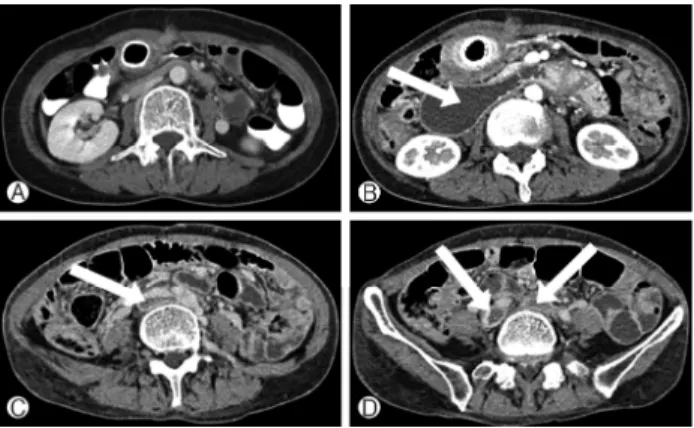CASE REPORT eISSN 2384-0293 https://doi.org/10.12701/yujm.2016.33.2.166 Yeungnam Univ J Med 2016;33(2):166-169
166 YUJM VOLUME 33, NUMBER 2, DECEMBER 2016
Deep vein thrombosis caused by malignant afferent loop obstruction
Eun Gyu Kang
1*, Chan Kim
2*, Jeungeun Lee
2, Min-uk Cha
2, Joo Hoon Kim
2, Seo-Hwa Park
1, Man Deuk Kim
3, Do Yun Lee
3, Sun Young Rha
21
Department of Internal Medicine, Hongik Hospital;
2Division of Medical Oncology, Department of Internal Medicine,
3
Department of Radiology, Yonsei University College of Medicine, Seoul, Korea
Afferent loop obstruction following gastrectomy is a rare but fatal complication. Clinical features of afferent loop obstruction are mainly gastrointestinal symptoms. A 56-year-old female underwent radical total gastrec- tomy with Roux-en-Y esophagojejunostomy for treatment of advanced gastric cancer. After fourteen months postoperatively, she showed gradual development of edema of both legs. Computed tomography (CT) scan showed disease progression at the jejunojejunostomy site and consequent dilated afferent loop, which resulted in inferior vena cava (IVC) compression. A drainage catheter was placed percutaneously into the afferent loop through the intrahepatic duct and an IVC filter was placed at the suprarenal IVC, and self- expanding metal stents were inserted into bilateral common iliac veins. With these procedures, sympotms related with afferent loop obstruction and deep vein thrombosis were improved dramatically. The follow-up abdominal CT scan was taken 3 weeks later and revealed the completely decompressed afferent loop and improved IVC patency. Surgical treatment should be considered as the first choice for afferent loop obstruc- tion; however, because it is more immediate and less invasive, non-surgical modalities, such as percuta- neous catheter drainage or stent placement, can be effective alternatives for inoperable cases or risky patients who have severe medical comorbidities.
Keywords: Afferent loop obstruction; Stomach cancer; Venous thrombosis; Interventional radiography
Received: June 19, 2015, Revised: August 10, 2015 Accepted: August 12, 2015
Corresponding Author: Sun Young Rha, Department of Internal Medicine, Yonsei University College of Medicine, 50 Yonsei-ro, Seodaemun-Ku, Seoul 03722, Korea Tel: +82-2-2228-8050, Fax: +82-2-362-5592 E-mail: rha7655@yuhs.ac
*
